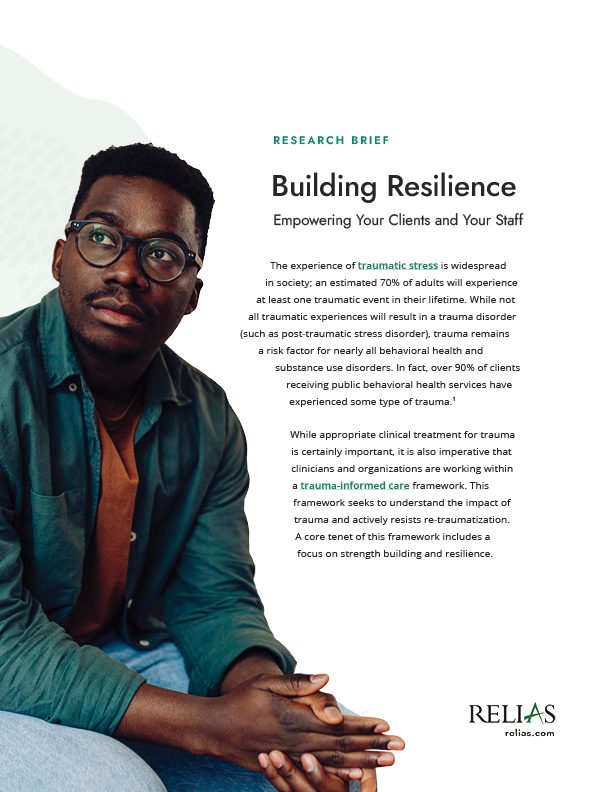Though the COVID-19 pandemic is waning, the changes it brought to healthcare persist. Longer hours for clinicians, increased rates of burnout among all providers, and higher rates of reported mental illness are now commonplace. While these and many other difficulties are challenging, organizations can respond by creating systems for building organizational resilience.
What is organizational resilience?

Organizational resilience is the ability of an organization to weather hard times. It’s when organizations are adaptable and trauma-informed and adopt a culture that fosters resilience within their staff.
Resilience has many definitions and facets. Here are some of our favorites:
- Resilience is often simply described as the ability to “bounce back” from life’s failures, stresses, or traumas.
- According to Joyce Marter, LCPC, resilience involves tapping into your strength to continue on your true path, despite facing obstacles and challenges.
- Social worker and best-selling author, Brené Brown, says that resilience is tolerating discomfort and painful emotions.
- One resilience researcher, Galen Buckwalter, has found that this ability consists of strength, purpose, and pleasure.
No matter how you define resilience, it’s an important part of keeping your organization strong.
Why is organizational resilience important for behavioral health providers?
Perhaps the most important thing to know about resilience is that it can be built. It is not just a trait you are naturally imbued with, but rather “an active practice” that anyone can engage in. In other words, even in turbulent times, resilience can be fostered.
Just as individual practices like self-care can ground you through hardship, building organizational resilience can help your clinicians and staff weather hard times. Resilience is particularly helpful when working with behavioral health clients because it mitigates the impacts of trauma and prevents burnout.
As mental health in America continues to worsen, behavioral health professionals will need more resilience than ever before. The effects of the mental health crisis can be seen in the following statistics:
- Master’s level licensed social workers are twice as likely to have PTSD as the general population. This may be because they are motivated by empathy to pursue work in the field.
- About half of mental health professionals reported moderate to high burnout, or exhaustion from work-related stress, before the pandemic. When clinicians experience burnout, they may have weaker boundaries, harming clients through effects like counter-transference.
Resilience can be thought of as solid ground to stand on, an anchor to your values when stress threatens to pull you away. At work, resilience is associated with job satisfaction, employee engagement, and interpersonal relationships. Resilience is also critical in your personal life and linked to self-esteem and a sense of control over life events.
Although we often think of resilience as an individual trait, it is also collective. After all, the ability to bounce back can sometimes be fostered best in a community.
How you can start building organizational resilience

The workplace, even if it’s still mostly virtual, offers a critical and uniquely effective setting to realize collective resilience.
Here are some concrete strategies for building organizational resilience in your behavioral health workforce:
- Build strong social relationships. Cultivate a sense of belonging among the team. Use strategies like case conferences to facilitate an environment in which staff can show up for each other. An important, and often overlooked, element of relationship building is developing a shared understanding of how to communicate and relate to each other. Build this healthy culture through conversations centered on gratitude, humor, and adaptability.
- Support team building. These days, you have to be especially creative in coordinating the logistics of team-building meetings. Consider new options like smaller, shorter gatherings outdoors over hot cocoa or digital settings you haven’t tried yet.
- Support autonomy. As much as you can, give your team members the autonomy to manage their work and even make organizational decisions. When issues arise, use nonjudgmental communication and other forms of trauma-informed supervision to find solutions together.
- Offer concrete support. Trying to prevent burnout among an overworked and underpaid staff is an uphill battle. The foundations of a resilient behavioral health workforce are reasonable caseloads, competitive wages, and benefits that allow staff to take care of their needs.
Develop safe and trusting environments. Resilience is often portrayed as positivity in the face of anything, but in hard times, resilience is also about naming and honoring struggle. Recognize that daily life is harder than it used to be for many folks on your team, and give them space to talk, even if they choose not to.

Building Resilience: Empowering Your Clients and Your Staff
Relias’ new white paper shares how people can, and do, recover from trauma. By building upon existing strengths and applying new tools for coping, you can foster resilience among individuals and within your organization.
Download the White Paper →





